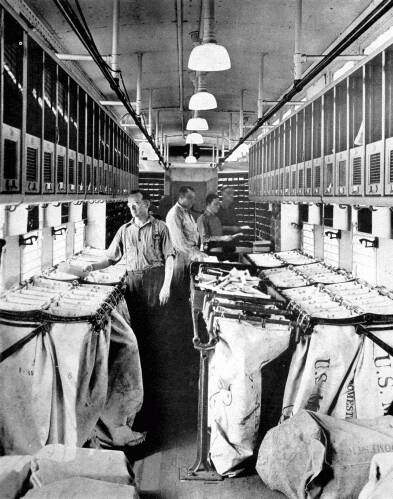|
Sorting Mail in a Railway Post Office
Car
 Before railway transportation
was introduced, the mails were carried on horseback, by stagecoach,
by sulky, by canal packet and by steamboat. Before railway transportation
was introduced, the mails were carried on horseback, by stagecoach,
by sulky, by canal packet and by steamboat.
Mail was slow, schedules were uncertain, and in many out-of-the-way
places deliveries were sometimes as much as three weeks or a month
apart. Postage rates were high.
Railway transportation greatly speeded up the movement of mails,
increased the dependability and frequency of deliveries and reduced
postage rates.
The first known instance of mails being transported by train
was behind the locomotive "West Point" at Charleston,
S. C., in November, 1831. By 1838, when Congress declared all
railroads to be post routes, mail was being carried on 1,500 miles
of railroad in this country. From that time forward, the route
mileage and the volume of mail carried by rail increased rapidly.
The vast expansion of the Post Office Department since the
advent of railroads is shown by the fact that total government
postal receipts increased from $2,000,000 in 1830 to $767,000,000
in 1940.
How railroads have speeded up the movement of mails is shown
by the following illustrations: in 1826 the fastest mail service
between Boston and Washington, D. C., by stagecoach was about
8 days, or 192 hours. Today mail is regularly transported by rail
between Boston and Washington in 9 hours. The fastest transit
of mail between St. Louis and San Francisco by Concord coaches
following the passage by Congress of the overland mail bill in
1857 was 25 days. Today railroads carry mail between St. Louis
and San Francisco in slightly more than 2 days. Mail is carried
by rail across the continent between New York and San Francisco
or Los Angeles in about 3 days.
The picture shows a typical scene in one of the numerous railway
post office cars which speed daily over the railroads of the United
States.
After a letter or parcel is canceled at the local post office,
it is placed in a mail pouch with other mail. The pouch is sealed,
labeled for a certain train and taken to the railway station by
a mail messenger or some other authorized person, who delivers
it to one of the railway mail clerks on the train. If the train
does not stop at that station, the pouch is attached to a mail
crane and put aboard in the manner described in the next chapter.
Once inside the car, the seal is broken and the contents of the
pouch are placed on a large sorting table. Around the table numerous
open pouches are held in place by racks. Each pouch is labeled
for a certain post office, distributing station or connecting
train. On the walls of the car are large cases for over-sized
mail and small cases with pigeon holes for first-class mail.
While the train is speeding along, the mail clerks are busy
sorting mail, making up pouches and performing other duties to
assure the prompt and proper handling of the mails. Pouches are
received and put off at nearly every station where there is a
post office. Letters and postal cards are sorted and tied into
bundles, each bundle bearing a slip showing the destination, the
railway post office's stamp and the clerk's name. Packages and
newspapers are placed in pouches, each of which is labeled for
a particular post office or connecting train.
Railway mail clerks develop remarkable speed and skill in the
sorting and handling of mail. They know hundreds of railway mail
routes. They memorize thousands of post offices and train connections,
so it is not necessary for them to keep looking up such information
in books or bulletins. Thus their memory helps them to do more
work than would otherwise be possible.
I've Been Working
on the Railroad | Contents Page
|







